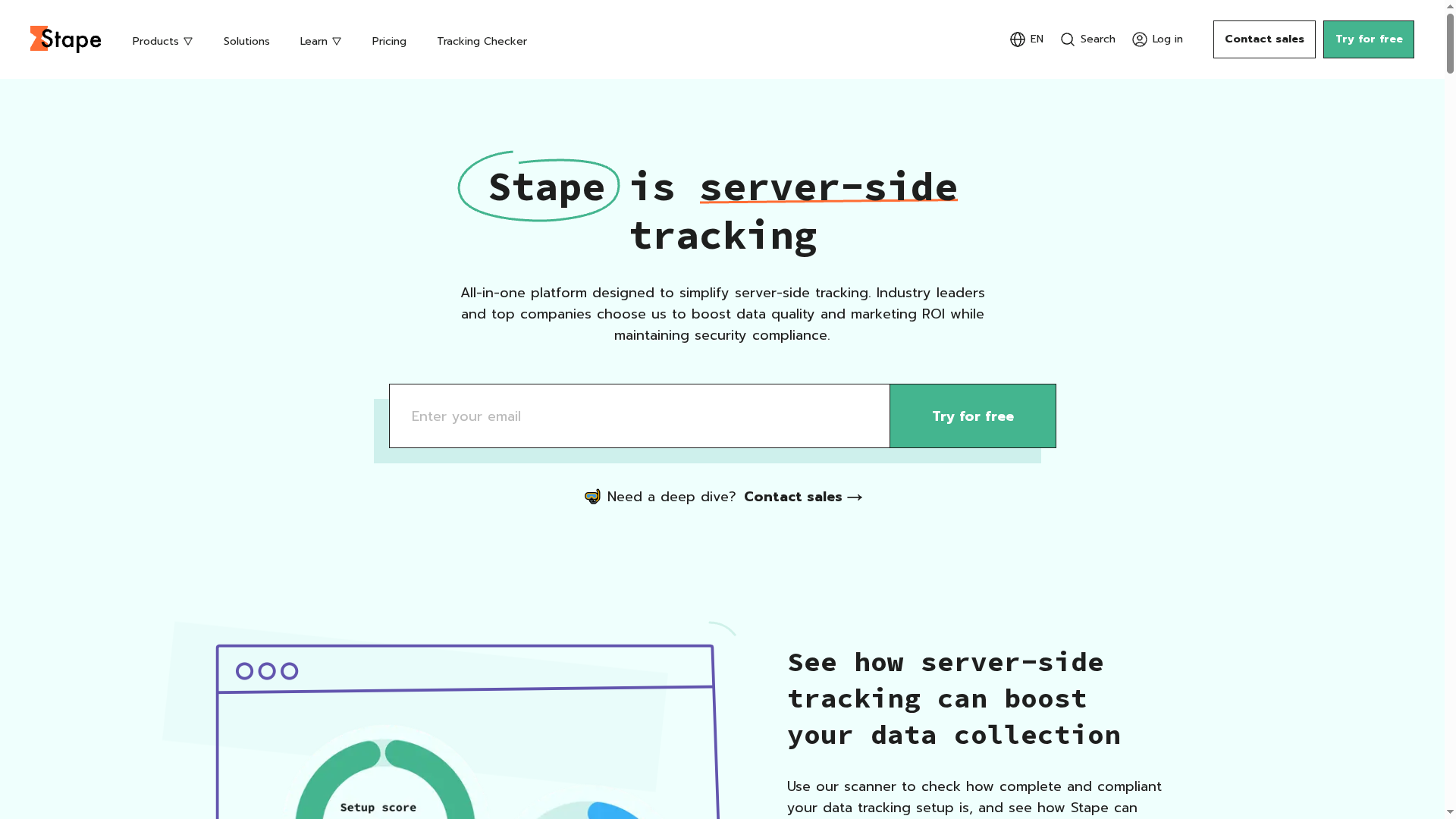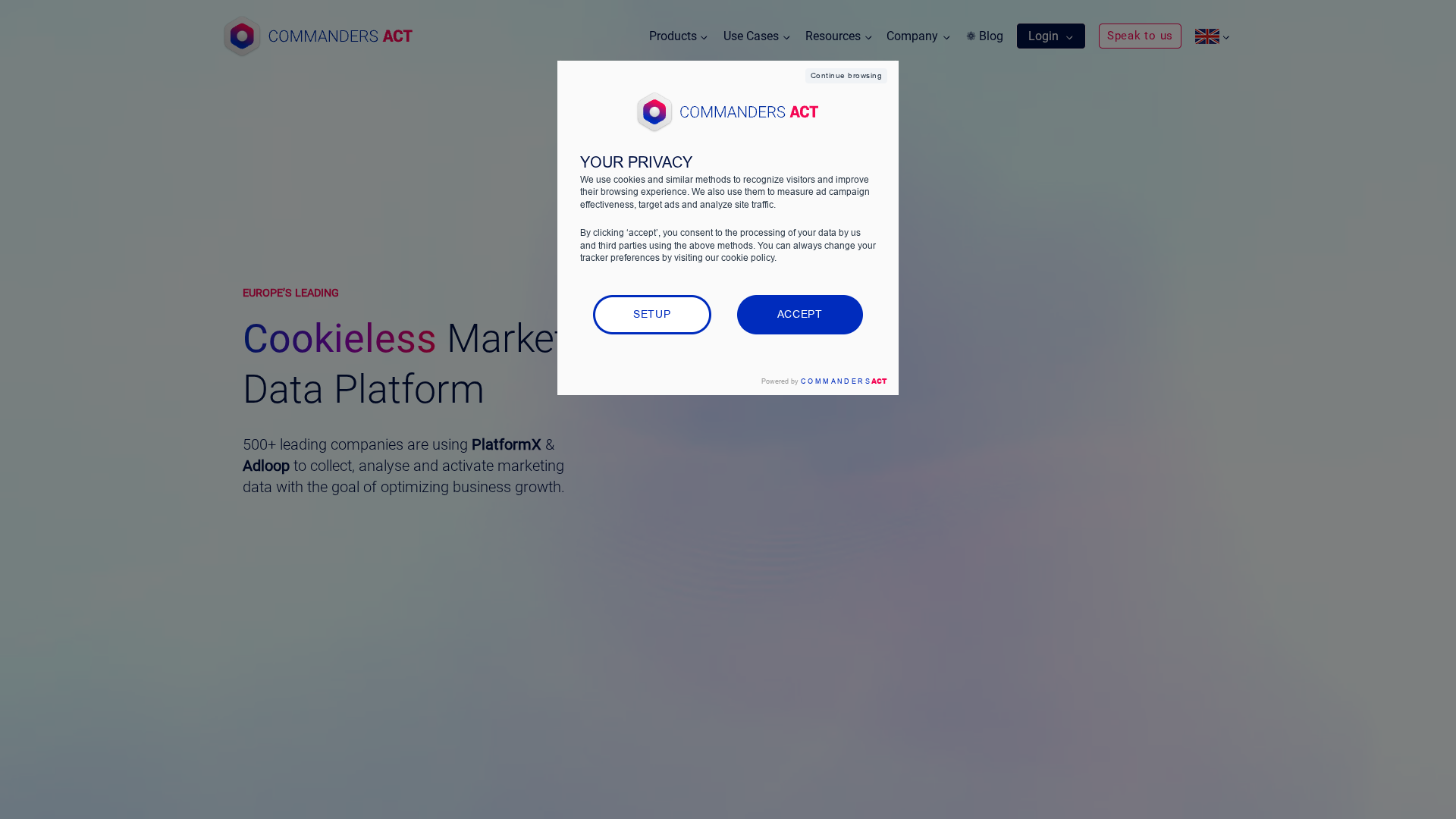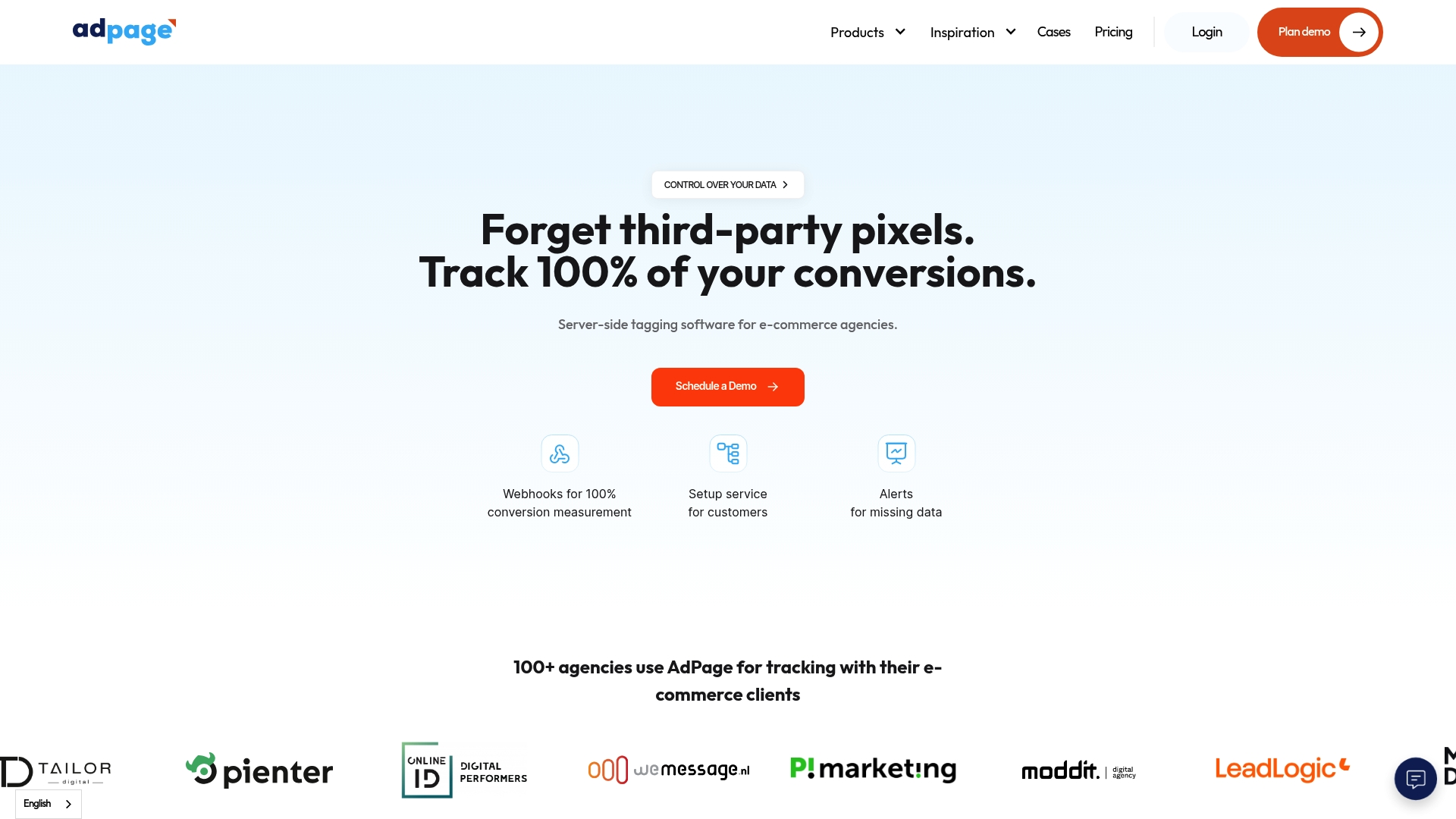Reliable tracking and accurate data are now more difficult to secure as new privacy rules and browser updates change the way online businesses measure results. Many teams find themselves searching for tools that can capture every conversion and insight without missing a beat or getting tangled up in complicated setups. The right platform can open the door to more trustworthy reports, better budget decisions, and smoother operations. Some options promise full control and deep insights while others aim for fast setup and easier data connections. The differences can have a big impact on campaign results and daily workflows. Which solution will fit your needs best and what makes each one special
Table of Contents
adpage.io

At a Glance
adpage.io is a server-side tagging platform purpose-built for e-commerce agencies, internal marketers and freelancers who demand complete confidence in conversion data. It combines server-side tagging, consent-aware collection and webhooks to capture what traditional client-side methods miss — the result is near-complete visibility into conversions. If you need reliable, GDPR-compliant data to drive ad spend decisions and CRO, adpage.io delivers that clarity with professional onboarding and continuous monitoring.
Core Features
adpage.io implements server-side tagging to prevent data loss from browser restrictions and ad-blockers, and it is designed to measure 100% of conversions using webhooks and advanced tracking flows. The platform offers a done-for-you setup service, where technicians handle the implementation and logins, plus 24/7 monitoring of tagging scripts and erroneous data. Integrations cover major e-commerce platforms including Shopify, WooCommerce, WordPress, Magento and Lightspeed C-series, and it connects to advertising and analytics tools such as Google Tag Manager and Google Analytics 4 (GA4). Additional functionality includes consent management and GDPR/AVG compliance, reporting tools and visitor identity support so you can stitch sessions into reliable conversion events.
Pros
- Guarantees complete conversion capture: adpage.io uses webhooks and real-time alerts to ensure conversions are recorded even when visitors never reach a traditional thank-you page.
- Professional, low-friction implementation: the done-for-you setup service reduces technical overhead for agencies and clients by handling credentials and configuration.
- Active monitoring prevents data rot: 24/7 monitoring flags tracking failures and incorrect data before they distort reports.
- Seamless platform compatibility: built integrations with Shopify, WooCommerce, Magento and others make deployment smoother across typical e-commerce stacks.
- Privacy-first architecture: designed for AVG/GDPR compliance so your tracking respects consent and data protection rules.
Who It’s For
adpage.io is ideal for e-commerce professionals — agencies that manage multiple merchant accounts, in-house marketers responsible for accurate attribution, and freelancers offering tracking-as-a-service. If your KPIs rely on precise conversion counts and you frequently optimise campaigns based on ROAS or AOV, this platform gives the trustable data pipeline you need.
Unique Value Proposition
What separates adpage.io is its single-minded focus on eliminating lost conversions and turning tracking into a dependable revenue signal. Unlike DIY client-side setups that break with browser updates or cookie restrictions, adpage.io routes critical events server-side, supplements them with webhooks that catch off-page conversions, and pairs that technical backbone with a hands-on setup team and continuous monitoring. The privacy and compliance framework is not an afterthought — it is embedded, reducing legal friction for agencies operating at scale. Yes, that level of control requires correct datalayer implementation and sometimes professional setup, but that trade-off is deliberate: you trade initial complexity and potential setup costs for long-term accuracy, reduced wasted ad spend and reproducible results.
Real World Use Case
An agency rolled out adpage.io across ten retail clients; the platform captured conversions missed by client-side scripts, alerted the team to a broken tag within minutes, and fed consistent data into GA4 and ad platforms. The agency used that reliable data to reallocate budget, increasing ROAS across campaigns within six weeks.
Pricing
Quote-based — contact adpage.io for a tailored proposal and setup options.
Website: https://adpage.io
Stape

At a Glance
Stape is an all-in-one platform that simplifies server-side tracking with an emphasis on improved data quality, privacy and easier integration. It bundles server-side Google Tag Manager hosting with multiple API gateways and data enrichment tools, which makes it attractive for marketing teams and agencies wanting reliable attribution without heavy engineering work. The bottom line: Stape reduces friction and raises tracking reliability, while enterprise customisation and high-traffic needs may incur higher costs.
Core Features
Stape provides hosted server-side Google Tag Manager, a Signals Gateway for secure data connection, and dedicated Conversions API gateways for Meta, TikTok and Snapchat. The platform also offers a Stape Store for data enrichment, automation that scales resources during traffic spikes, and multiple API gateways to centralise event forwarding. Setup is designed to be straightforward, requiring minimal technical skills for basic deployments, and enterprise clients can request custom solutions for complex architectures.
Pros
- Easy setup and integration: Stape emphasises minimal technical overhead, allowing teams to get server-side tracking running quickly without a deep engineering backlog.
- Enhanced data security and privacy: Hosting server-side tag containers and using gateways reduces client-side data leakage and helps maintain privacy compliance across campaigns.
- Improved data accuracy and tracking reliability: Centralised server-side processing increases the completeness and consistency of events sent to advertising platforms and analytics systems.
- Comprehensive solutions including API gateways and data enrichment: Built-in gateways for Meta, TikTok and Snapchat plus the Stape Store enable richer, platform-specific integrations and enhanced payloads.
- Support for enterprise and custom solutions: Stape offers customisable configurations and enterprise options to handle large or specialised deployments.
Cons
- Limited information on specific limitations or drawbacks from the website content: The available product data does not detail performance caps, regional hosting options or explicit SLA terms, leaving some operational questions unanswered.
- Possible cost considerations for high-traffic needs or enterprise customisation: While a freemium entry exists, scaling to high-volume use or bespoke enterprise work is likely to require paid, custom plans and could increase total cost.
- No detailed user testimonials or comparative analysis included in the provided content: The material does not include independent customer success metrics or head-to-head comparisons with other server-side providers.
Who It’s For
Stape suits digital marketers, data analysts and developers who need a pragmatic route to server-side tracking without building infrastructure from scratch. It is particularly useful for agencies and brands wanting to improve attribution, reduce cookie-deprecation impact and maintain GDPR-compliant pipelines while avoiding long engineering projects.
Unique Value Proposition
Stape’s unique value lies in packaging server-side GTM hosting, multi-platform API gateways and data enrichment into a single platform that is simple to deploy. That combination lets marketing teams regain visibility and reliability in conversion tracking faster than building bespoke server-side solutions.
Real World Use Case
A mid-sized e-commerce business deploys Stape’s server-side Google Tag Manager and Meta/TikTok gateways to centralise event collection. The result is more consistent attribution across channels, fewer lost conversions due to browser restrictions, and clearer ROI reporting for paid campaigns.
Pricing
Freemium plan available, starting at $20/month for hosting; custom solutions for high traffic websites, trial options for various gateways.
Website: https://stape.io
Stape

At a Glance
Stape is an all-in-one server-side tagging platform that focuses on improving data quality, security and marketing ROI for digital teams. It simplifies server-side tagging setup while offering first-party data collection and a suite of API gateways for major ad channels. The platform scales automatically during traffic spikes and includes monitoring and debugging tools that make operations more reliable. Bottom line: Stape is well suited for teams that need a practical, production-ready route to server-side tracking without building infrastructure from scratch.
Core Features
Stape provides server-side tagging setup via Google Tag Manager and a Signals Gateway that routes data from multiple sources to destinations. It supports first-party data collection and incorporates dedicated gateways such as Meta Conversions API Gateway, TikTok Events API Gateway and Snapchat Conversions API Gateway to centralise event delivery to advertising platforms. The service offers automatic resource autoscaling for traffic spikes, built-in monitoring and debugging, and custom enterprise options including private clusters, dedicated SLAs and compliance agreements.
Pros
- Simplifies server-side tracking setup so marketing and analytics teams can deploy server-side containers faster than building bespoke infrastructure.
- Offers a wide range of integrations and power-ups which helps centralise event routing and reduces the number of fragile client-side hooks.
- Supports privacy regulation compliance and data security through private clusters and compliance agreements, which is critical for GDPR-conscious organisations.
- Provides customer support and an active community that assists with troubleshooting and implementation nuances.
- Delivers scalable infrastructure suitable for high-traffic websites, including automatic autoscaling to handle spikes without manual intervention.
Cons
- Pricing details may be sparse in some cases, which means teams often need to contact sales to understand full costs for enterprise or custom configurations.
- Some advanced features and integrations still require technical understanding, so non-technical teams may need engineering support during setup.
- Specific limitations of any free tier or trial options are not fully specified, which can make proof-of-concept budgeting harder for small teams.
Who It’s For
Stape is aimed at marketers, data analysts and technical teams responsible for digital analytics and conversion tracking who want an easy-to-implement, secure and scalable server-side solution. It fits agencies and e-commerce teams that require reliable delivery to ad platforms and need to reclaim data lost to browser restrictions or blockers.
Unique Value Proposition
Stape’s core strength is packaging production-ready server-side tagging and first-party data collection into a managed platform that reduces operational overhead. The combination of API gateways for ad channels, autoscaling infrastructure and enterprise compliance options positions Stape as a pragmatic bridge between marketing teams and engineering-heavy server-side deployments.
Real World Use Case
A marketing team at an e-commerce site uses Stape to implement server-side tracking, improving accuracy for Facebook and Google Ads campaigns, ensuring GDPR compliance and recovering events lost to ad blockers—resulting in clearer attribution and better campaign ROI.
Pricing
Starting at $20/month (freemium plan available for GTM or hosting); custom solutions are available for high-traffic needs.
Website: https://stape.io
Twilio Segment

At a Glance
Twilio Segment is a robust customer data platform that centralises clean, consented customer data to power real‑time insights and personalised interactions. It excels at unifying disparate data sources and enriching customer profiles as interactions occur, making it a strong choice for teams that need immediate activation across many tools. However, the platform’s complexity and quote‑based pricing mean smaller teams should evaluate technical readiness and budget before committing. Overall, it’s a sophisticated, enterprise‑grade solution for businesses serious about data‑driven engagement.
Core Features
Twilio Segment automatically enriches customer profiles with every interaction and unifies data across more than 700 connectors, supporting real‑time behavioural event tracking and activation. The platform layers AI for predictive and generative customer insights and provides powerful data governance and privacy controls to help maintain compliance with privacy regulations and standards. Its architecture also supports warehouse‑based activation, giving teams flexibility in how they store and operationalise their data.
Pros
- Comprehensive integration with over 700 destinations and sources enables teams to route and activate data across the tools they already use without extensive custom engineering.
- Real‑time data collection and activation capabilities mean you can trigger campaigns and personalise journeys the moment a user takes action.
- AI‑driven insights provide predictive signals that help teams anticipate customer needs and tailor communications accordingly.
- Robust security and privacy features give enterprises confidence that their customer data is governed and compliant with relevant standards.
- Flexible architecture supporting warehouse data activation allows organisations to leverage existing data infrastructure for advanced analytics and reporting.
Cons
- Pricing details are available upon request, which may be costly for small businesses and makes budgeting less transparent.
- Setup and ongoing management can be complex for non‑technical users, requiring dedicated engineering or analytics resources.
- The platform requires existing infrastructure, such as a data warehouse, for full utilisation, which adds implementation overhead for teams starting from scratch.
Who It’s For
Twilio Segment is best suited to medium and large enterprises with complex data needs that want to unify and activate customer data at scale. If you have engineering or analytics bandwidth and multiple marketing, product, or analytics tools to integrate, Segment helps you centralise and operationalise that data. Smaller teams or those without a data warehouse should weigh implementation effort and cost carefully.
Unique Value Proposition
Segment’s unique value is its scale and breadth: more than 700 connectors, real‑time activation, and AI‑enabled insights combine to turn fragmented signals into a single, actionable customer truth. For organisations that need guaranteed data quality, consent management, and enterprise‑grade governance while activating across many destinations, Segment reduces the friction between data collection and data activation.
Real World Use Case
Allergan uses Twilio Segment to identify consumers, understand profile traits, and personalise communications according to journey status, which improved engagement and operational efficiency by enabling more relevant outreach and consistent identity resolution across channels.
Pricing
Quote‑based; pricing details are available upon request, and a free trial is offered for certain features.
Website: https://segment.com
Commanders Act

At a Glance
Commanders Act is presented as Europe’s leading cookieless marketing data platform, used by over 500 companies to collect, analyse and activate marketing data without relying on third‑party cookies. Its strength lies in enterprise‑grade capabilities — real‑time processing, unified customer profiles and server‑side readiness — delivered in a privacy‑compliant environment. For large teams that need robust attribution and activation, it’s a compelling option; however, access restrictions and a potentially steep implementation curve are important caveats.
Core Features
Commanders Act combines cookieless data collection via first‑party tracking beacons with server‑side integration and GTM readiness, creating a foundation for accurate, privacy‑friendly tracking. The platform builds unified customer profiles through a real‑time customer data platform (CDP), and offers data transformation, enrichment and quality‑control tools. It also centralises marketing data in a data hub, supports data‑driven attribution and KPIs, and provides AI‑based recommendations for ad and campaign performance alongside dynamic audience segmentation and multi‑channel activation.
Pros
- Strong privacy-first design: The platform’s cookieless approach and compliance focus make it well suited for environments where GDPR and similar regulations matter. This reduces reliance on third‑party trackers.
- Real‑time processing and attribution: Commanders Act processes data in real time, enabling faster optimisation cycles and more timely campaign decisions.
- Comprehensive end‑to‑end toolset: From collection to activation, the product covers profiling, attribution and campaign analysis, which reduces the need to stitch multiple vendors together.
- Flexible and customisable offering: The product is described as highly flexible, allowing bespoke setups that align with enterprise needs and complex tech stacks.
- Responsive support and collaboration: High availability of support and strong inter‑team collaboration are highlighted, which helps during rollout and ongoing optimisation.
Cons
- Content access is limited: Key documentation or assets are password‑protected, which can slow initial evaluation and proof‑of‑concept work.
- Complex setup for new users: The platform’s breadth and customisability mean implementation can be complex and may require specialist support or professional services.
- Opaque pricing: Pricing is not publicly disclosed and requires direct contact, which complicates upfront budget planning and quick procurement decisions.
Who It’s For
Commanders Act is aimed at large enterprises and digital marketing teams that need a cookieless, privacy‑compliant platform with advanced targeting, attribution and analytics. If your organisation handles substantial marketing volume across channels and needs centralised, real‑time customer data for optimisation at scale, this product is a fit.
Unique Value Proposition
The platform’s unique value proposition is its combination of cookieless, first‑party data capture with enterprise CDP capabilities and server‑side integrations, enabling privacy‑first measurement and activation without fragmenting the stack. That single‑platform approach appeals to organisations prioritising compliance and unified analytics.
Real World Use Case
A company centralises its marketing data in Commanders Act, builds unified customer profiles for cross‑device reconciliation, and uses real‑time attribution to optimise bids and creative across channels — improving ROI while keeping tracking compliant with privacy rules.
Pricing
Not publicly disclosed; requires direct contact for details.
Website: https://commandersact.com
Server-Side Tagging and Data Management Tools Comparison
This table provides a quick overview of key server-side tagging and customer data management platforms, focusing on their core features, advantages, disadvantages, target users, and pricing structures.
| Product | Core Features | Pros | Cons | Target Users & Pricing |
|---|---|---|---|---|
| adpage.io | Server-side tagging, consent management, webhooks, e-commerce integrations | Guarantees complete conversion capture, professional setup, 24/7 monitoring, GDPR compliance | Professional setup might be necessary | E-commerce agencies; contact for quote-based pricing |
| Stape | Server-side GTM hosting, API gateways for Meta/TikTok/Snapchat, data enrichment | Easy setup, enhanced data privacy, strong data accuracy, comprehensive API support | Potential costs for custom solutions, no detailed user testimonials | Digital marketers and agencies; from $20/month, custom solutions |
| Twilio Segment | Centralises customer data, over 700 connectors, AI-driven insights, warehouse data activation | Comprehensive integration, real-time activation, AI insights, robust security | Complex setup, quote-based pricing, requires existing infrastructure | Medium to large enterprises; quote-based pricing |
| Commanders Act | Cookieless data platform, real-time CDP, server-side tracking, marketing data centralisation | Privacy-first design, real-time processing, comprehensive end-to-end toolset | Complex setup, opaque pricing, limited access to documentation | Large enterprises focused on privacy; pricing not publicly disclosed |
Unlock Reliable Conversion Tracking with Server-Side Tagging Solutions
The challenges highlighted in the article around lost conversions and inaccurate data caused by browser restrictions and cookie limitations are a reality for many e-commerce marketers. Accurate attribution and comprehensive tracking are essential for optimising return on ad spend and improving decision making. If you identify with the difficulty of capturing every conversion or managing GDPR-compliant consent while maintaining data quality, server-side tagging is the breakthrough your strategy needs.
AdPage specialises in precise server-side tagging setups that eliminate traditional data loss issues. With professional onboarding and 24/7 monitoring, your e-commerce platform can gain complete confidence in conversion data across Shopify, WooCommerce, Magento and more. Benefits include:
- Consent-aware data collection respecting privacy regulations
- Real-time alerts preventing tracking failures
- Visitor identity stitching for accurate user journeys
Discover how to reclaim lost revenue and power growth with flawless tracking at AdPage’s official site. Ready to transform how you measure success and maximise your ad spend? The longer you wait, the more data you risk losing. Explore the full potential now with the AdPage platform.

Take control today. Visit AdPage and step confidently towards data-driven marketing that truly converts.
Frequently Asked Questions
What is server-side tagging, and why is it important for digital marketing?
Server-side tagging processes tracking data on the server rather than in the user’s browser, improving accuracy and security. Implement this method to capture comprehensive data, especially in environments burdened by privacy regulations or browser restrictions.
How do I choose the best server-side tagging tool for my business?
Assess your specific needs, such as ease of setup, integration capabilities, and compliance features. Create a checklist of your essential requirements and compare tools based on these factors to ensure you select a solution that aligns with your goals.
What are the benefits of using server-side tagging tools compared to traditional client-side tagging?
Server-side tagging tools enhance data reliability by reducing data loss from ad blockers and providing better privacy compliance. Switch to server-side tagging to achieve up to 100% data capture, which can significantly improve your tracking accuracy.
How can I implement server-side tagging in my existing setup?
Start by choosing a compatible server-side tagging tool that integrates well with your existing systems. Follow the tool’s setup guide and consider hiring a professional for the initial implementation to ensure optimal configuration and data flow.
What are common challenges faced during server-side tagging implementation?
Challenges include ensuring proper configuration of data layers and managing consent for data collection. Prepare for potential technical hurdles by allocating resources to your implementation team and providing them with adequate training on the selected tool.
How do I measure the success of my server-side tagging implementation?
Monitor key performance indicators such as conversion rates, data accuracy, and user interaction metrics post-implementation. Review these metrics regularly, ideally within the first 30 days, to adjust your approach as necessary and optimize performance.



.png)
